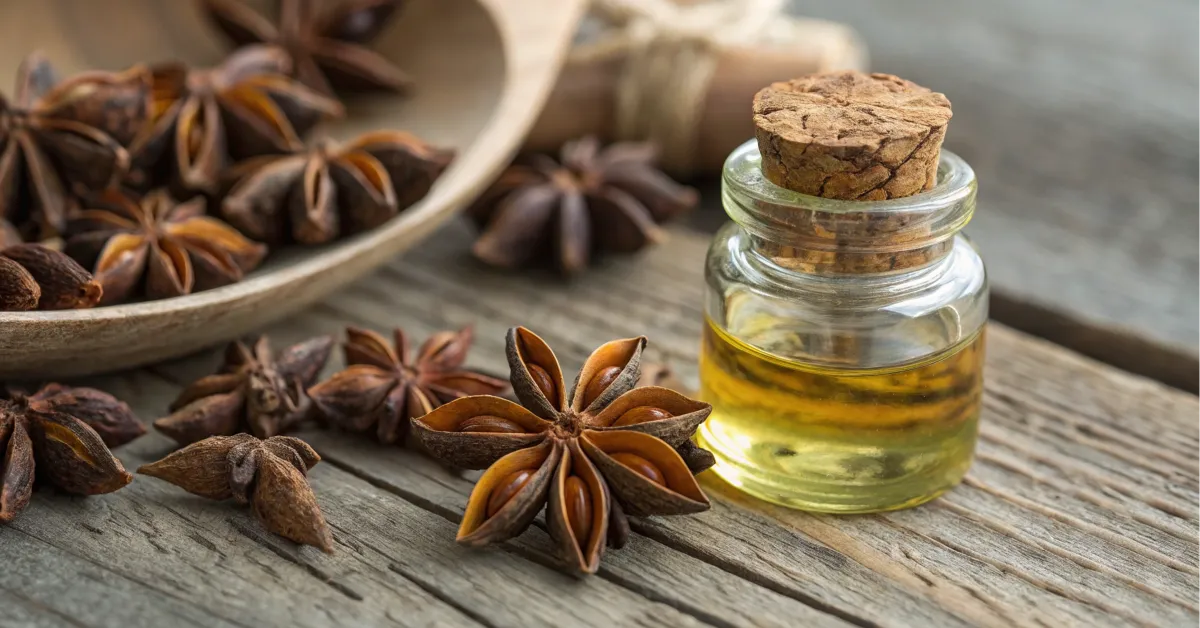Is Anise Oil the Same as Licorice? Understanding the Key Differences? Many people confuse anise oil with licorice because they share a similar flavor profile. Both are sweet, aromatic, and used in culinary and medicinal applications. However, they are not the same. Their origins, chemical properties, and uses vary greatly. This article dives deep into the key differences between anise oil and licorice. You’ll also learn how to make your own anise oil at home, understand its health benefits, and discover who should avoid using it. By the end of this guide, you’ll be equipped with all the knowledge to use these ingredients confidently and correctly.
Table of contents
What Are Anise Oil and Licorice?
Understanding Their Origins
Anise oil comes from the seeds of the anise plant (Pimpinella anisum), which thrives in Mediterranean climates. The seeds are carefully distilled to extract a fragrant essential oil. This oil is rich in anethole, a compound responsible for its sweet, slightly spicy aroma.
Licorice, conversely, comes from the root of the Glycyrrhiza glabra plant. This plant belongs to the legume family and thrives in Asia and parts of Europe. Additionally, licorice root contains glycyrrhizin, a compound that is remarkably sweet—up to 50 times sweeter than sugar. Furthermore, it has earthy and medicinal undertones, which set it apart from the flavor of anise oil.
Differences in Composition
The key difference lies in their chemical composition. Anise oil is primarily composed of anethole, a light and aromatic compound. Licorice root is rich in glycyrrhizin, which gives it a heavier, sweeter, and more medicinal taste. While they may taste similar, their origins and uses are worlds apart.
Did You Know? Despite their flavor similarities, anise and licorice do not come from the same plant family. Anise belongs to the parsley family, while licorice is a legume.
For a deeper dive into how anise oil can enhance your cooking and wellness, visit Anise Oil Uses and Recipes. It’s a must-read for anyone curious about this versatile ingredient.
Key Differences Between Anise Oil and Licorice
Although they share a similar flavor, anise oil and licorice serve different purposes. Knowing their distinctions can help you use them effectively in the kitchen or for health benefits.
Flavor and Aroma
- Anise Oil: Sweet, fresh, and slightly spicy. Its aroma is light and uplifting.
- Licorice: Earthy, sweet, and lingering. Its flavor has a heavier medicinal quality.
Culinary Applications
Anise oil is widely used in European baking and is often paired with spices like cinnamon or nutmeg. It is also a popular choice for flavoring beverages, including herbal teas, ouzo, and absinthe. Licorice, however, shines in candies, syrups, and teas. It is also a key ingredient in savory dishes in Asian cuisine, such as marinades and sauces.
Pro Tip: When substituting anise oil for licorice in recipes, use it sparingly. Anise oil is more concentrated and could easily overpower your dish.
Health Benefits
Anise oil is often used for its digestive properties. It can help reduce bloating and soothe an upset stomach. Licorice, on the other hand, is known for its ability to ease sore throats and coughs. However, it should be consumed in moderation, as excessive glycyrrhizin can lead to health issues like high blood pressure and low potassium levels.
Cultural Significance
In Mediterranean and Middle Eastern cultures, anise oil is a staple in desserts and beverages. Licorice has long been used in Chinese traditional medicine for its soothing properties. Understanding these cultural contexts can help you appreciate their unique roles.
How to Make Homemade Anise Oil
Making your own anise oil is easier than you might think. It’s a great way to ensure freshness and purity while customizing the flavor to suit your needs. Plus, it can save you money compared to store-bought options.
Ingredients and Equipment
Here’s what you’ll need to get started:
| Ingredient | Amount | Notes |
|---|---|---|
| Anise seeds | 2 tsp | Fennel seeds can be a substitute |
| Carrier oil (e.g., olive) | 100 ml | Almond oil is another option |
| Glass jar with lid | 1 | Make sure it’s sterilized and airtight |
| Strainer or cheesecloth | 1 | For removing seeds from the oil |

Step-by-Step Instructions
- Lightly crush the anise seeds using a mortar and pestle. Crushing releases the essential oils and enhances the flavor.
- Place the seeds in a sterilized glass jar.
- Add the carrier oil of your choice, ensuring the seeds are fully submerged.
- Seal the jar tightly and store it in a cool, dark place for at least two weeks. Shake the jar gently every few days to mix the ingredients.
- After two weeks, strain the mixture through cheesecloth or a fine strainer to remove the seeds.
- Transfer the oil to a dark glass bottle to protect it from light and preserve its quality.
Why Make It Yourself?
Homemade anise oil is fresher and more flavorful than most store-bought options. It also gives you the freedom to experiment. For example, you can add other spices like star anise or cinnamon for a unique twist. Plus, it’s satisfying to create something from scratch!
If you’re looking for inspiration on how to use your homemade anise oil, check out Anise Oil Uses. It’s full of creative ideas to elevate your cooking.

Who Should Avoid Anise Oil?
While anise oil is generally safe, there are certain groups of people who should avoid it. This is especially important for individuals with specific health conditions or sensitivities.
Groups to Avoid It
- Pregnant Women: Anise oil has compounds that can mimic estrogen. This makes it potentially unsafe during pregnancy.
- People with Allergies: Those allergic to plants in the parsley family, such as celery or fennel, should steer clear of anise oil.
- Individuals with Hormone-Sensitive Conditions: Conditions like breast cancer or endometriosis may worsen with anise oil due to its estrogen-like effects.
Safer Alternatives
If you’re sensitive to anise oil, there are several substitutes you can try:
- Fennel Oil: Offers a similar flavor with a slightly milder aroma.
- Star Anise Extract: A popular alternative in baking and cooking.
- Licorice Root: While different in composition, it can serve as a substitute in some recipes.
Pro Tip: Always consult with a healthcare provider before using essential oils if you have underlying health conditions or are taking medications.
Substitutes for Anise Oil
If you don’t have anise oil or need a substitute for dietary or health reasons, don’t worry. There are several great options. Each alternative brings a unique flavor while keeping the essence of anise intact. Choosing the right substitute depends on your recipe and personal taste.
Top Substitutes
- Star Anise Extract
Star anise extract is a top choice. It has a similar licorice-like flavor, though slightly bolder. Use it in baking or beverages for a near-identical taste. Replace anise oil with star anise extract in equal amounts. - Fennel Oil
Fennel oil is another excellent option. It offers a milder sweetness with a gentle spice. It works well in desserts and savory dishes. Use slightly more fennel oil to match the intensity of anise oil. - Licorice Root Powder
Licorice root powder provides a deep, earthy sweetness. It’s perfect for candies, teas, or baked goods. However, its strong flavor means you should use it sparingly to avoid overpowering the dish. - Vanilla Extract and Cinnamon
A mix of vanilla extract and a touch of cinnamon is a creative substitute. While it doesn’t taste exactly like anise, it adds warmth and sweetness, making it ideal for cookies or cakes. - Clove Oil
Clove oil has a sharp, spicy flavor. It’s best for marinades, savory dishes, or spiced desserts. Add it in small amounts, as its boldness can easily overwhelm other flavors.

FAQs: Everything You Need to Know About Anise Oil and Licorice
This section answers common questions about anise oil and licorice. From safety concerns to usage tips, here’s what you need to know.
What is another name for anise oil?
Anise oil is also called “anise seed oil” or “anethole oil.” These names reflect its origins from anise seeds and its primary flavor compound, anethole.
Why was black licorice taken off the market?
Black licorice was removed from some markets due to health concerns. Its glycyrrhizin content can cause low potassium and high blood pressure when consumed in excess. This highlights the importance of moderation when enjoying licorice products.
Who should not take anise?
Certain groups should avoid anise:
- Pregnant Women: Anise may mimic hormones and should be avoided during pregnancy.
- People with Allergies: Those allergic to celery, parsley, or related plants should not consume anise.
- Individuals with Hormone-Sensitive Conditions: People with conditions like breast cancer or endometriosis should consult a doctor before using anise.
If you’re curious about pairing ingredients with specific flavors, explore What Does Cottage Cheese Go Well With?.
What is a substitute for anise oil?
Popular substitutes include star anise extract, fennel oil, and licorice root powder. Each brings a similar flavor profile with unique variations. For example, vanilla extract mixed with cinnamon can offer a warm and sweet alternative for desserts.
Does anise oil smell like licorice?
Yes, anise oil has a sweet, licorice-like scent. This is because both contain the compound anethole, which gives them their characteristic aroma. For more insights into its fragrance and uses, visit What Does Anise Oil Smell Like?.

Pro Tips and Variations
Anise oil can elevate any dish, but using it correctly is key. These tips and creative ideas will help you get the most out of this versatile ingredient.
Expert Tips for Success
- Start Small: Anise oil is very strong. Begin with a tiny amount and adjust to taste.
- Enhance Desserts: Pair anise oil with vanilla, nutmeg, or citrus zest for added complexity in baked goods.
- Preserve Its Flavor: Add anise oil toward the end of cooking to retain its delicate aroma.
Creative Variations
- Citrus Fusion: Combine anise oil with lemon or orange zest for a fresh, zesty flavor. This works well in cakes or muffins.
- Warm Spices: Mix anise oil with cinnamon and ginger to create a unique spice blend for cookies or pies.
- Savory Infusion: Add a drop to a marinade for chicken or pork to introduce a subtle, aromatic twist.

Conclusion
Vanilla wine biscuits provide a classic treat enjoyed by many. Moreover, traditional recipes typically include gluten; however, creating gluten-free versions proves simple and rewarding. Accordingly, by using alternative flours, accurate measurements, and careful techniques, you can bake biscuits that remain safe for everyone and equally delicious as the original.
Additionally, these biscuits suit any occasion. Furthermore, you can serve them with coffee, pair them with wine, or transform them into desserts for a special touch. With the tips, recipes, and creative ideas shared in this guide, you will undoubtedly make gluten-free vanilla wine biscuits that impress every time. For more information on gluten-free diets and safe ingredient choices, visit the Wikipedia page on Gluten-Free Diets.

